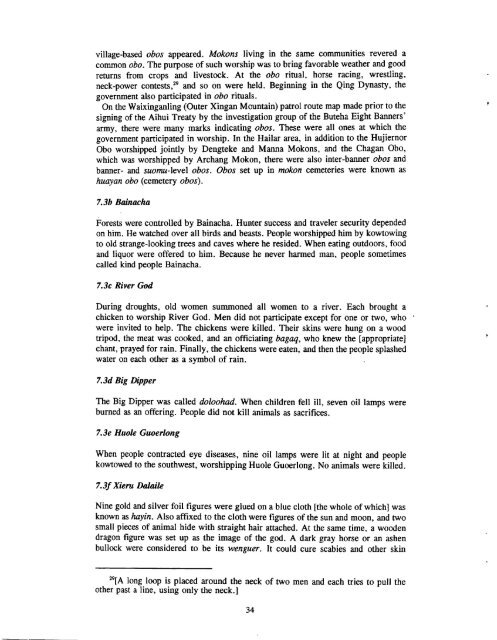China's Dagur Minority - Sino-Platonic Papers
China's Dagur Minority - Sino-Platonic Papers
China's Dagur Minority - Sino-Platonic Papers
Create successful ePaper yourself
Turn your PDF publications into a flip-book with our unique Google optimized e-Paper software.
village-based obos appeared. Mokons living in the same communities revered acommon obo. The purpose of such worship was to bring favorable weather and goodreturns from crops and livestock. At the obo ritual, horse racing, wrestling,neck-power ~ontests,'~ and so on were held. Beginning in the Qing Dynasty, thegovernment also participated in obo rituals.On the Waixinganling (Outer Xingan Mountain) patrol route map made prior to thesigning of the Aihui Treaty by the investigation group of the Buteha Eight Banners'army, there were many marks indicating obos. These were all ones at which thegovernment participated in worship. In the Hailar area, in addition to the HujiernorObo worshipped jointly by Dengteke and Manna Mokons, and the Chagan Obo,which was worshipped by Archang Mokon, there were also inter-banner obos andbanner- and suom-level obos. Obos set up in mokon cemeteries were known ashuayan obo (cemetery obos).Forests were controlled by Bainacha. Hunter success and traveler security dependedon him. He watched over all birds and beasts. People worshipped him by kowtowingto old strange-looking trees and caves where he resided. When eating outdoors, foodand liquor were offered to him. Because he never harmed man, people sometimescalled kind people Bainacha.7.3~ River GodDuring droughts, old women summoned all women to a river. Each brought achicken to worship River God. Men did not participate except for one or two, whowere invited to help. The chickens were killed. Their skins were hung on a woodtripod, the meat was cooked, and an officiating bagaq, who knew the [appropriate]chant, prayed for rain. Finally, the chickens were eaten, and then the people splashedwater on each other as a symbol of rain.7.3d Big DipperThe Big Dipper was called doloohad. When children fell ill, seven oil lamps wereburned as an offering. People did not kill animals as sacrifices.7.3e Huole GwerlongWhen people contracted eye diseases, nine oil lamps were lit at night and peoplekowtowed to the southwest, worshipping Huole Guoerlong. No animals were killed.Nine gold and silver foil figures were glued on a blue cloth [the whole of which] wasknown as hayin. Also affixed to the cloth were figures of the sun and moon, and twosmall pieces of animal hide with straight hair attached. At the same time, a woodendragon figure was set up as the image of the god. A dark gray horse or an ashenbullock were considered to be its wenguer. It could cure scabies and other skin"[A long loop is placed around the neck of two men and each tries to pull theother past a line, using only the neck.]34
















